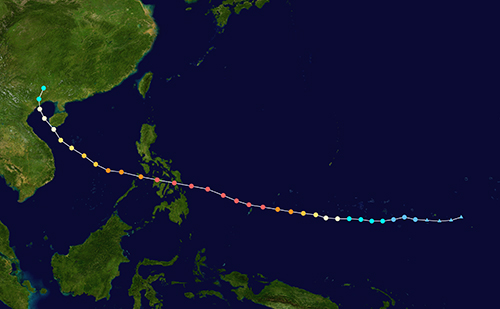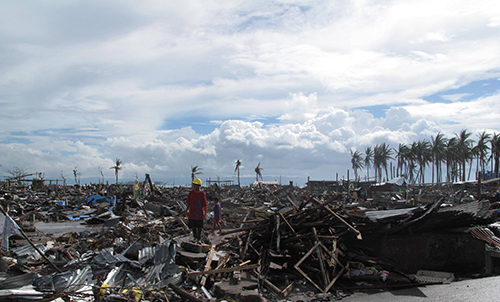
Learning From Typhoon Haiyan
Nov 20, 2014
Editor's Note: One year ago, the most powerful typhoon in the Philippines' history left a humanitarian disaster in its wake, along with far-reaching economic impacts. Read about what is being done to improve the country's future resilience to natural catastrophes, including AIR's role in disaster risk assessment, risk reduction, and risk financing projects led by the World Bank and the Asian Development Bank.
The Philippines lies in the direct path of many of the typhoons that track westward across the ocean. An archipelago of more than 7,000 islands scattered over 1,830 km2 is a large target; the region is struck by about 18-20 typhoons annually, 5-10 of which typically make landfall on one of the country's main islands. Natural disasters (the Philippines also occupies a particularly active portion of the Pacific "Ring of Fire") have a significant impact on the economy, costing on average about 0.5% of the gross domestic product each year. As development continues at a rapid pace, the economic cost of natural disasters is rising, and spending on reconstruction and relief is likely to become unsustainable unless resources are diverted to the management and reduction of future risks.
At the time Super Typhoon Haiyan struck in late 2013, the Government of the Philippines had been working proactively on disaster risk reduction and climate change adaptation to help the country escape from its vicious cycle of destruction and reconstruction. The Disaster Risk Reduction and Management Act of 2010 appointed a cabinet minister to lead each of the four aspects of the disaster management cycle—preparedness; response; prevention and mitigation; and rehabilitation and recovery. Other measures include requiring at least 5% of each local authority's revenue to go into its Local Disaster Risk Reduction Management Fund and the 2011 launch of a National Disaster Risk Reduction and Management Plan. The government aimed for a casualty-free typhoon season in 2013, but the plans it had in place were no match for the most powerful storm in the country's history.
Super Typhoon Haiyan
The Philippines is no stranger to super typhoons—even late in the year. Super Typhoon Bopha arrived in December 2012 with winds of 280 km/h, and Typhoon Megi made landfall in late October 2010 with winds of 232 km/h, according to the Joint Typhoon Warning Center (JTWC).
Haiyan, known locally as Yolanda, formed on November 3, 2013, some 3,000 km east-southeast of the Philippines. With minimal vertical wind shear and a long fetch of warm water, Haiyan had a lengthy runway to spin up to super typhoon status before reaching its first target.
The extent of the Northwest Pacific basin allows warm ocean water (>26°C) to develop to great depths. Strong easterly trade winds pile up the warm water along the east coast of the Philippines, fueling the intensification of approaching storms. The depth of the warm water has increased over the last 20 years from 95 to 115 meters. Importantly, while Haiyan traveled over surface water only slightly warmer than normal, the water 100 meters below was nearly 3°C warmer than its historical average. In addition, Haiyan's rapid forward speed meant that upwelling, which brings cooler water to the surface and slows tropical cyclone development, was minimized. The most rapid intensification occurred over a 24-hour period ending shortly before landfall, as Haiyan deepened from 965 mb down to 905 mb, according to the Japan Meteorological Agency (JMA). But Haiyan wasn't done; it deepened another 10 mb before landfall.

Haiyan is noted by the JTWC to be the strongest tropical cyclone in recorded history, with one-minute average sustained wind speeds of 312 km/h. The JMA's estimate is much lower at 264 km/h. Despite this discrepancy (read more about it in this article), there is no disagreement that Haiyan was a super typhoon when it struck the Philippines with the strongest winds the country had ever seen.
Even more deadly than its wind was the substantial storm surge generated by Haiyan. Because of the storm's track, extreme winds, and the bathymetry and orientation of San Pedro Bay, an exceptional storm surge was funneled toward Tacloban City, where water levels were rose more than 5 meters above tide level. Fortunately the storm arrived at low tide—at high tide the surge would have been almost 1 meter higher.
The Aftermath
According to the United Nations Office for the Coordination of Humanitarian Affairs (OCHA), 14 million people across 44 provinces were affected by the typhoon. More than 1 million homes were damaged, including more than half a million destroyed. In addition to more than 6,000 dead and almost 2,000 missing, 4.1 million people were displaced by the storm. The scale of devastation wrought was so overwhelming that, despite advance preparations, many of the resources put in place beforehand were damaged by the storm. Many of the agencies responsible simply could not cope.

Based on the AIR Typhoon Model for Southeast Asia (which captures losses due to wind and precipitation-induced flooding, but not storm surge), AIR issued a modeled insured loss estimate a week after Haiyan's landfall of between USD 300 million and USD 700 million, which is consistent with current industry information. However, the insured loss is a very small portion of the total damage sustained to properties (which AIR estimated to be between USD 6.5 billion and USD 14.5 billion), reflecting the small fraction of properties that are insured.
Looking Forward—Recovery, Prevention, Mitigation
Over the past year, there has been an increase in the demand as well as the availability of typhoon/flood insurance. However, while the insurance market in the Philippines is one of the fastest growing in the Southeast Asia region, the life sector dominates by a wide margin, and property insurance take-up is likely to remain low, especially for the most vulnerable households. Insurance alone will not cover the gap between losses from natural disasters and the funds needed to help communities rebuild, which places additional stresses on the government and may impede future economic growth. In addition to improving immediate response and relief efforts, such as better pre-positioning of personnel, equipment, food, and medicine, as well as the disbursement of emergency funding, a number of long-term public and private initiatives are needed to make the Philippines better prepared for the next major typhoon.
Coastal Development
One way to address the threat from storm surge (and tsunami) is to rebuild away from the vulnerable coast. The "no dwelling zone," in which structures can be built but no one may reside, was within 20 meters from the sea prior to Haiyan—similar easements elsewhere in the Pacific range from 50-200 meters. An early response to Haiyan was to increase the easement to 40 meters, which quickly proved unpopular and hard to enforce. Fishermen in particular are reluctant to move away from their boats and equipment, and the authorities often don't have the money to buy land for relocation even if it is available with clear title. In Tacloban alone, some 14,500 homes needed to be built.
Furthermore, a 40-meter easement gives no consideration to elevation, which is an important determinant of a location's hazard. The Office of the Presidential Assistant for Rehabilitation and Recovery initiated a survey using multi-hazard maps to scope out each area's topography and degree of vulnerability to certain disasters. Areas are to be zoned as safe, unsafe, or controlled—in which construction will be permitted as long as there are mitigating measures, such as mangroves, catch basins, or seawalls.
Money has been earmarked for the restoration of mangrove and natural beach forests to make the coast less vulnerable to extreme weather events. More than 1,900 hectares of the Eastern Visayas, particularly the province of Leyte and its capital Tacloban City, are to be planted. These clustered "green belts" are intended for sustainable activities like ecotourism and will give fishermen access to the shore. Typhoon survivors are to be employed on seedling production, planting site preparation, planting, and maintenance.
There is also a need to educate coastal residents about the dangers of storm surge. Thanks to the evacuation measures undertaken, the loss of life was less than the scale of physical destruction suggested. Nevertheless, many people did not comprehend the nature of storm surge, and others in at-risk locations could not—or would not—leave their homes and possessions. After the event, many complained that the authorities should have communicated the danger more clearly.
Build It Back Stronger
Another clear need is improving local building codes, as a large percentage of structures in the Philippines— particularly in more rural regions—did not stand a chance against Haiyan's winds and storm surge. Again, enforcement will prove difficult because the people whose homes are most at risk are among those least able to comply. Many dwellings in the devastated communities were made of light and readily available materials. In the rush to rebuild, people used whatever they could find—often materials salvaged from the debris surrounding them.
The key to reconstruction is a multifaceted approach—including the involvement of local communities, job creation, private investment, and effective monitoring of progress. Aid groups on the ground are providing materials and training to empower residents to build stronger shelters for their families. However, long-term recovery, including the building of more permanent, durable housing, will be a challenge, hampered by a lack of funding and the massive coordination needed to deal with a humanitarian situation of this scale.
Resilience, and AIR's Role
In the year since Haiyan, the road to recovery has been long and often uncertain for the authorities, relief organizations, and victims alike. One key challenge to improving the nation's future resilience to natural catastrophes is for public and private stakeholders to understand the scope of the risk and potential financial impact before major events occur. In addition to providing modeling tools that serve the private insurance market, AIR has participated in several catastrophe risk assessment projects for the World Bank and regional development banks to assist some of the world's most vulnerable nations. This includes ongoing studies for the Asian Development Bank to establish an integrated disaster risk management framework in select cities in Vietnam, Indonesia, and the Philippines, as well as the entire country of Bangladesh. AIR has also previously completed a study for the World Bank—the Pacific Catastrophe Risk Assessment and Financing Initiative (PCRAFI)—to quantify the natural disaster risk faced by 15 small island nations in the South Pacific. In January 2014, Tonga was the first country to benefit from a payout under the Pacific Catastrophe Risk Insurance Pilot (PCRIP), a derivative of the PCRAFI study, and received an immediate payment of USD 1.27 million towards recovery from Cyclone Ian. AIR developed the underlying risk models and provides the post-event loss calculation for the PCRIP transaction.
More recently, AIR is utilizing its expertise to assist the Government of the Philippines, through a World Bank Technical Assistance program, with its disaster risk management objectives. This 2014 study furthers the understanding of earthquake and typhoon hazard in the Philippines, the vulnerability of the population and built environment, as well as the direct and indirect financial costs. The study will inform the possible development of physical mitigation strategies, as well as market-ready disaster risk finance mechanisms such as catastrophe bonds and insurance pools. The hope is that while typhoons like Haiyan (and worse) are inevitable in the Philippines' future, the impact—including loss of life, property damage, and other catastrophic social and economic effects—can be significantly reduced in a cost-effective manner.
 By: Peter Sousounis
By: Peter Sousounis By: Ashish Jain
By: Ashish Jain